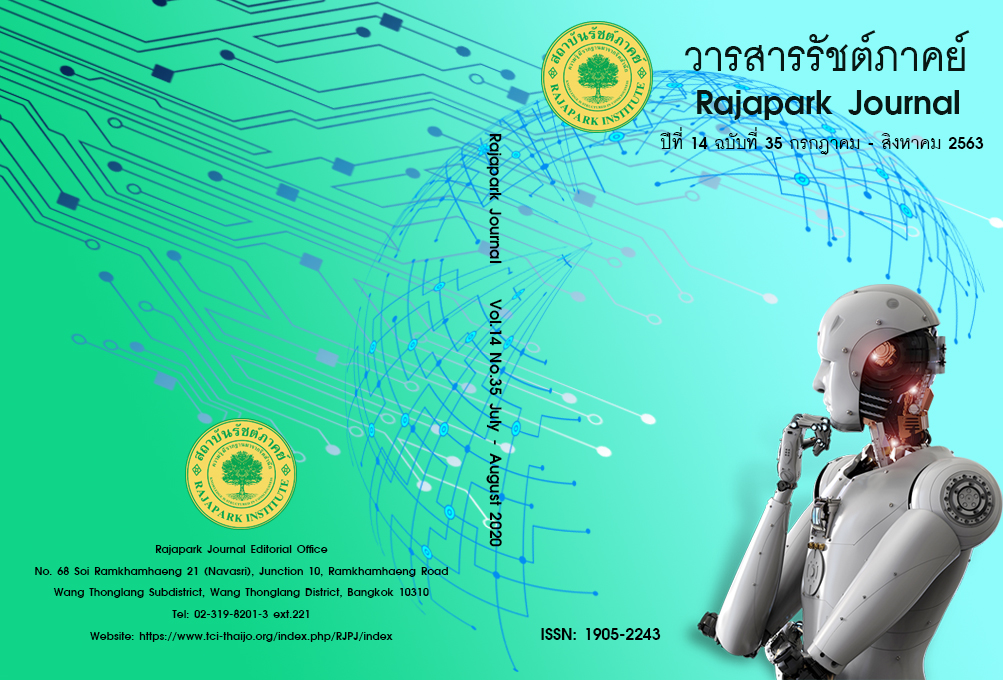Chinese tourist’s satisfaction toward the spa business in Thailand
Main Article Content
Abstract
The purposes of this study were as follows: 1) to learn Chinese tourist’s satisfaction toward the spa business in Thailand; 2) to learn the service quality perceptions of Chinese tourist; and 3) to analyse and suggest the way to manage spa businesses in Thailand to welcome Chinese tourists who experiences spa service in Thailand. The study was a qualitative research by in-depth interview from the key informant persons 3 groups that was; 1) government sectors 9 people; 2) private sectors 10 people; and 3) tourists 10 people. The study revealed that the spa businesses in Thailand’s outstanding and accepted by international tourists in term of the quality of service standard are qualified, quality staff at spa services. In terms of tourism marketing, especially spa products are varied and outstanding for services, using natural local products and show Thainess, and mark the price as “High value” – that’s why the price for service is quite high. Also, there are doing the online and offline marketing that could reach to the large amount of customers and tourists. The ways to manage spa businesses to welcome Chinese tourists has many aspects, can be concluded to be 7 topics including; 1) the standard and security; 2) the public relations; 3) the rules about run the business correctly; 4) the support budget from government; 5) the co-cooperating from community; 6) the business and others stakeholders to looking for strength; and 7) the rules to punish scammer for tourists.
Article Details
Views and opinions appearing in the Journal it is the responsibility of the author of the article, and does not constitute the view and responsibility of the editorial team.
References
Access Chinese Comprehensive Marketing Consultant. (2016). Thailand's tourism trend statistics of Chinese people for the year 2016. Retrieved January 15, 2020, from https://www.thaipr.net/travel/750504
Chantawanit, S. (2010). Qualitative research methods. (18th ed.). Bangkok: The Publisher of Chulalongkorn University.
Cohen, M. (2008). “Spa introduction”, in Cohen, M. and Bodeker, G. (Eds), Understanding the Global Spa Industry: Spa Management. Elsevier, Cambridge: MA.
Khamchana, S. (2014). A Study on Marketing Mix Satisfaction for Health Tourism of Scandinavian Tourists in Baby Boom Generation B Group in Pattaya City. Master of Management. Faculty of Management and Tourism, Burapha University.
Kotler, P. (1994). Marketing management: Analysis, planning, implementation, and control. (8th ed.). Englewood Cliffs, NJ: Prentice Hall.
Leangsangthong, S. (2015). Thai spa, the relaxation paradise of Chinese tourists. Retrieved December 15, 2018, from https://www.bangkokbiznews.com/blog/detail/635316
Longprasert, S. (2019). Development of spa business standards in Koh Samui district Surat Thani
Province To the ASEAN Economic Community. Journal of Management Science, 1(1), 125-141.
Maynard, W. S. (1995). Responding to Social Change. Pensylvania: Dowden Hutchision & Press.
Ministry of Tourism and Sports. (2016). Tourism Economic Report No. 3. Retrieved January 12, 2018, from https://www.mots.go.th/content.php?nid=7618
Niemsakun, S. (2013). Consumers’ Perception of Toyota Camry Hybrid Brand Image in Bangkok Metropolitan Region. Master of Arts. Rajamangala University of Technology Phra Nakhon.
Sawaenghasab, Y. (2015). Development of Service Blueprint for Health and Wellness Spa in Thailand. Master Degree of Science. Service Innovation College of Innovation, Thammasat University.
Thammasam, S. (2011). Management of spa business in Mueang District Chonburi province. Bangkok: Research and Development Institute, Suan Sunandha Rajabhat University.
Tourism Authority of Thailand. (2009). Tourism Statistics 2009. Bangkok: Tourism Research and Statistics Division, Tourism Authority of Thailand.
Travel M Thai. (2016). 10 Ranking Places to Visit in Thailand Chinese beloved. Retrieved December 20, 2018, from https://travel.mthai.com/blog/104915.html
Untong, A., & Kaosa-ard, M. (2014). Spas Performances Benchmarking and Operation Efficiency. Applied Economics Journal, 21(1), 1-19.


